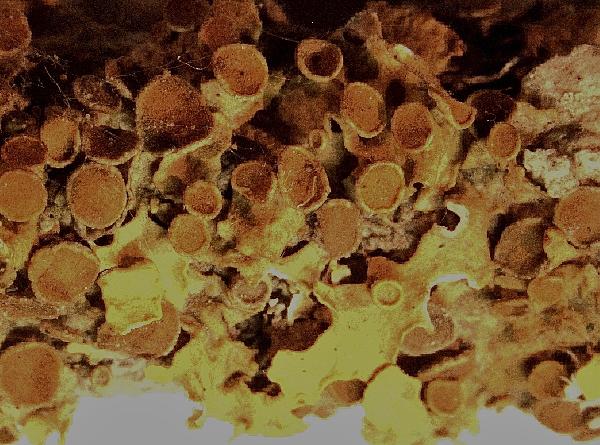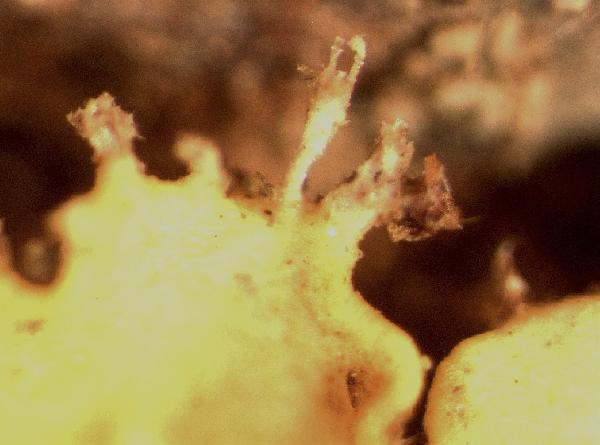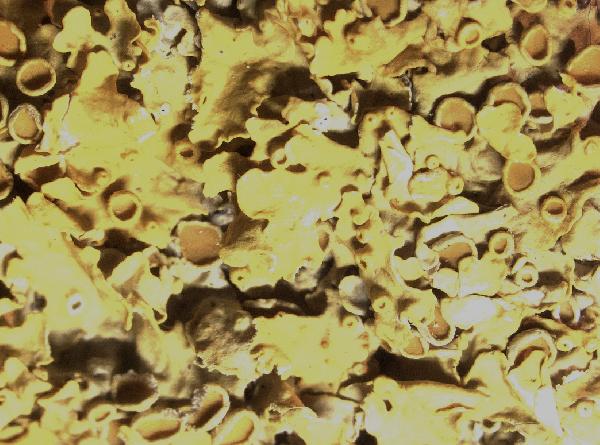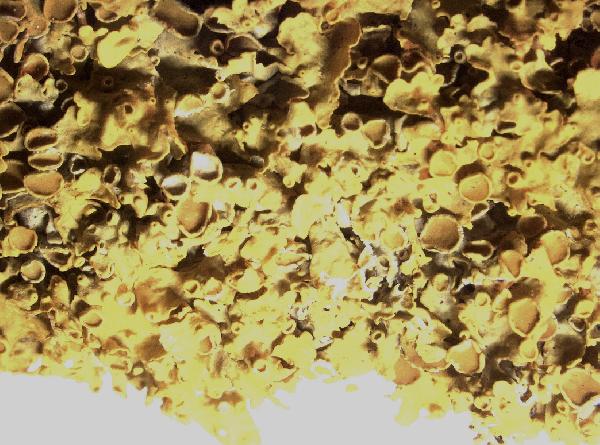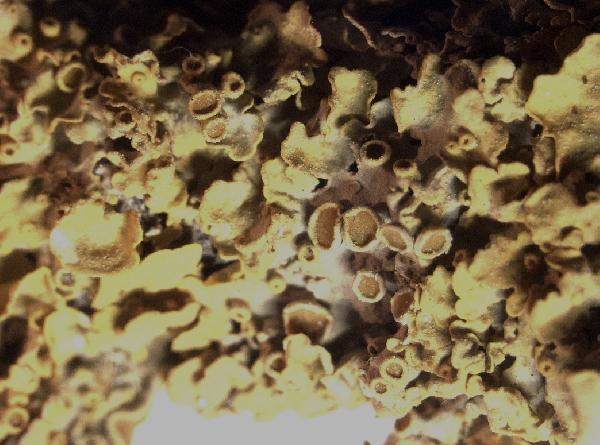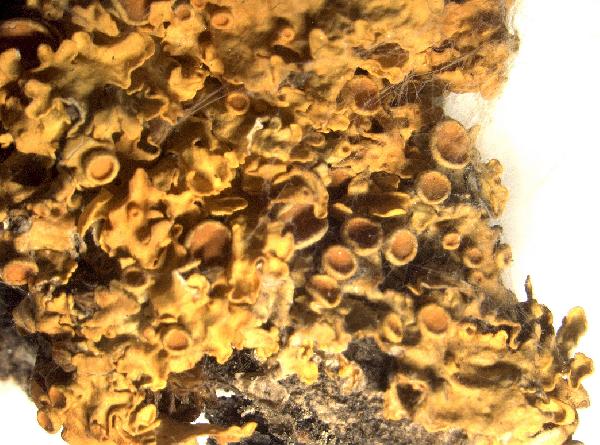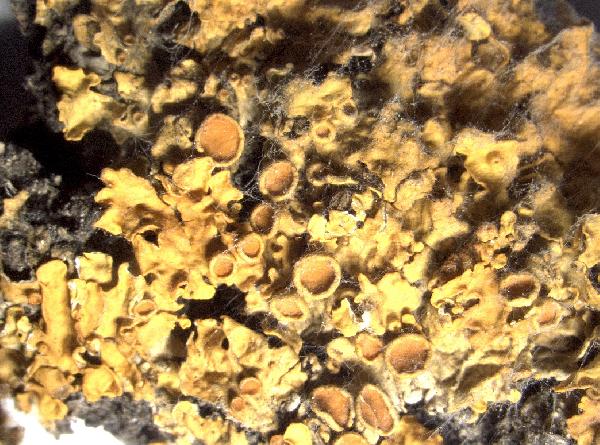Xanthoria microspora B. de Lesd.
Bull. Soc. bot. Fr., 104: 319, 1957
Synonyms: Xanthoria monofoliosa S.Y. Kondr. & Kärnefelt nom. inval. ?
Distribution: S - Si (Kondratyuk & al. 2024).
Description: Thallus foliose, heteromerous, dorsiventral, yellow to deep orange, not forming monophyllous rosettes, the lobes strap-shaped, undulate, overlapping, forming a very lax, multi-layered network, attached at a single basal point (most evident in young lobes), up to 7-8(-12) mm long, (0.2-)0.5-1.0(-1.5) mm wide at base, gradually broadening and becoming richly branched towards the tips, flat to subconcave, with a thicker rim, often subdivided into apical secondary lobes. Lower surface paler than upper surface, with 0.2-0.7 mm long, marginal, simple or basally branched cilia-like hapters gradually tapering towards the tips. Upper cortex (7-)10-15 µm thick, palisadę paraplectenchymatous; medulla to 50-60 µm thick, often with 30-45 µm thick scleropletenchymatous bundles; lower cortex mesodermatous paraplectenchymatous, to 20 µm thick. Apothecia lecanorine-zeorine, 0.5-1.7 mm across, distinctly stipitate, with a flat to slightly convex disc, and a usually slightly paler, up to 75 µm thick thalline margin. Epithecium orange, K+ purple-red; hymenium colourless, (40-)50-70 µm high; paraphyses swollen towards the tips (to 5-6 µm wide); hypothecium colourless, 15-20 µm high. Asci (5-)6-8-spored, clavate, Teloschistes-type. Ascospores 2-celled, polarilocular, hyaline, (6-)7-13(-16) x (4.5-)5-7(-9) µm, the equatorial thickening (“septum”) (3-)4-9(-12) µm long. Pycnidia usually somehow darker orange than thallus. Conidia ellipsoid to bacilliform. Photobiont chlorococcoid. Spot tests: thallus and apothecia K+ purple-red, C-, KC-, P-, UV+ intensely orange-red. Chemistry: unknown, but probably with parietin (major), fallacinal, emodin, teloschistin and parietinic acid.Note: molecular data demostrate that in Southern Europe X. parietina is heterogeneous, and that more than one species is involved (Spielmann & al. 2021, Kondratyuk & al. 2024). The species discussed here is the enigmatic epiphytic lichen mentioned by Nimis (1993) in the the note to X. parietina, from which it mainly differs in the strap-shaped lobes resembling those of X. aureola or X. ectaneoides. For Italy it was first mentioned from Sicily (Riserva dello Zingaro, Prov. Palermo) by Scherrer & Honegger (2003) as X. ectaneoides (see Kondratyuk & al. 2024). In TSB there are several other specimens from Mediterranean Italy, mostly growing on twigs nor far from the coast, which are presently under study. They correspond fairly well with the description of X. monofoliosa S.Y. Kondr. & Kärnefelt, a species known from South Africa, Macaronesia and the Mediterranean (incl. the Middle East). Unfortunately, that name is illegitimate, as no type material was designated by Kondratyuk & al. (2008). For this reason, I provisionally attribute them to the similar X. microspora, described from Egypt and also known from Israel, although its type material, according to Kondratyuk & al. (2024), is poorly developed and needs revision.
Growth form: Foliose, narrow lobed
Substrata: bark
Photobiont: green algae other than Trentepohlia
Reproductive strategy: mainly sexual
Commonnes-rarity: (info)
Alpine belt: absent
Subalpine belt: absent
Oromediterranean belt: absent
Montane belt: absent
Submediterranean belt: absent
Padanian area: absent
Humid submediterranean belt: absent
Humid mediterranean belt: rare
Dry mediterranean belt: very rare
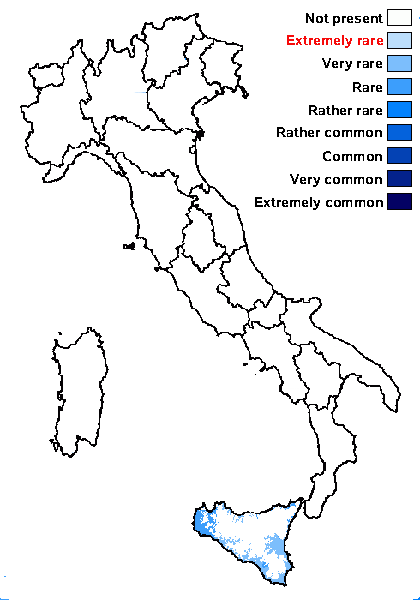
Predictive model
Growth form: Foliose, narrow lobed
Substrata: bark
Photobiont: green algae other than Trentepohlia
Reproductive strategy: mainly sexual
Commonnes-rarity: (info)
Alpine belt: absent
Subalpine belt: absent
Oromediterranean belt: absent
Montane belt: absent
Submediterranean belt: absent
Padanian area: absent
Humid submediterranean belt: absent
Humid mediterranean belt: rare
Dry mediterranean belt: very rare

Predictive model
